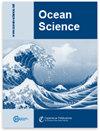利用机器学习将卫星与基因联系起来,从太空估算浮游植物群落结构
IF 4.1
3区 地球科学
Q2 METEOROLOGY & ATMOSPHERIC SCIENCES
引用次数: 0
摘要
摘要。海洋颜色遥感用于估算初级生产力已有 20 多年的历史。根据空间光谱数据,特别是结合光合色素的原位测量数据,还开发了一些方法来分解浮游植物群落结构。在此,我们提出了一种新的海洋颜色算法,用于推算七个浮游植物群的相对细胞丰度,以及它们对全球总叶绿素 a(Chl a)的贡献。我们的算法以机器学习为基础,并利用遥感参数(不同波长的反射率、反向散射和衰减系数,以及温度和叶绿素 a),结合利用塔拉海洋数据开发的基于组学的生物标志物进行训练,该生物标志物代表一个单拷贝基因,该基因编码光合作用机制的一个组成部分,存在于所有浮游植物中,包括原核生物和真核生物。它不同于以往依靠诊断色素来推断浮游植物类别的方法。我们的方法从相对细胞丰度和对总 Chl a 浓度的贡献两个方面对浮游植物群落结构进行了可靠的估计。新生成的数据集提供了浮游植物不同方面的互补信息,对评估不同浮游植物群对初级生产力的贡献和推断群落组合过程非常有价值。这使得遥感观测成为收集基本生物多样性变量(EBVs)的绝佳工具,并为开展海洋生物多样性预测奠定了基础。本文章由计算机程序翻译,如有差异,请以英文原文为准。
Linking satellites to genes with machine learning to estimate phytoplankton community structure from space
Abstract. Ocean color remote sensing has been used for more than 2 decades to estimate primary productivity. Approaches have also been developed to disentangle phytoplankton community structure based on spectral data from space, in particular when combined with in situ measurements of photosynthetic pigments. Here, we propose a new ocean color algorithm to derive the relative cell abundance of seven phytoplankton groups, as well as their contribution to total chlorophyll a (Chl a) at the global scale. Our algorithm is based on machine learning and has been trained using remotely sensed parameters (reflectance, backscattering, and attenuation coefficients at different wavelengths, plus temperature and Chl a) combined with an omics-based biomarker developed using Tara Oceans data representing a single-copy gene encoding a component of the photosynthetic machinery that is present across all phytoplankton, including both prokaryotes and eukaryotes. It differs from previous methods which rely on diagnostic pigments to derive phytoplankton groups. Our methodology provides robust estimates of the phytoplankton community structure in terms of relative cell abundance and contribution to total Chl a concentration. The newly generated datasets yield complementary information about different aspects of phytoplankton that are valuable for assessing the contributions of different phytoplankton groups to primary productivity and inferring community assembly processes. This makes remote sensing observations excellent tools to collect essential biodiversity variables (EBVs) and provide a foundation for developing marine biodiversity forecasts.
求助全文
通过发布文献求助,成功后即可免费获取论文全文。
去求助
来源期刊

Ocean Science
地学-海洋学
CiteScore
5.90
自引率
6.20%
发文量
78
审稿时长
6-12 weeks
期刊介绍:
Ocean Science (OS) is a not-for-profit international open-access scientific journal dedicated to the publication and discussion of research articles, short communications, and review papers on all aspects of ocean science: experimental, theoretical, and laboratory. The primary objective is to publish a very high-quality scientific journal with free Internet-based access for researchers and other interested people throughout the world.
Electronic submission of articles is used to keep publication costs to a minimum. The costs will be covered by a moderate per-page charge paid by the authors. The peer-review process also makes use of the Internet. It includes an 8-week online discussion period with the original submitted manuscript and all comments. If accepted, the final revised paper will be published online.
Ocean Science covers the following fields: ocean physics (i.e. ocean structure, circulation, tides, and internal waves); ocean chemistry; biological oceanography; air–sea interactions; ocean models – physical, chemical, biological, and biochemical; coastal and shelf edge processes; paleooceanography.
 求助内容:
求助内容: 应助结果提醒方式:
应助结果提醒方式:


